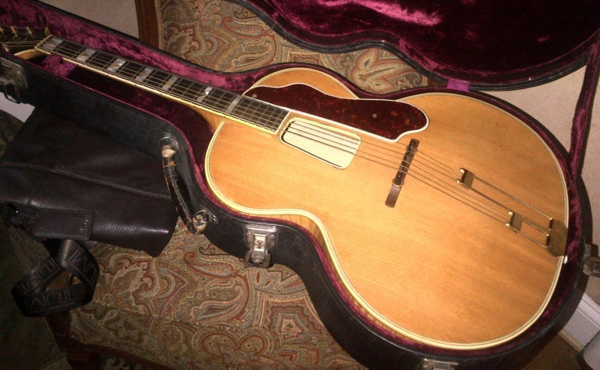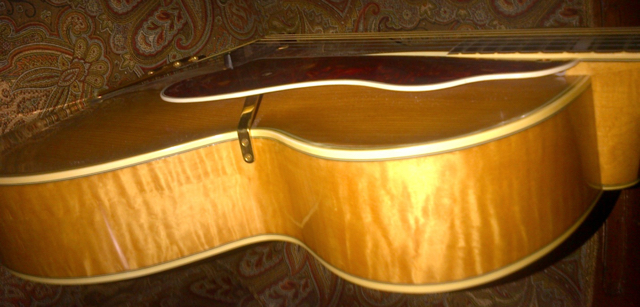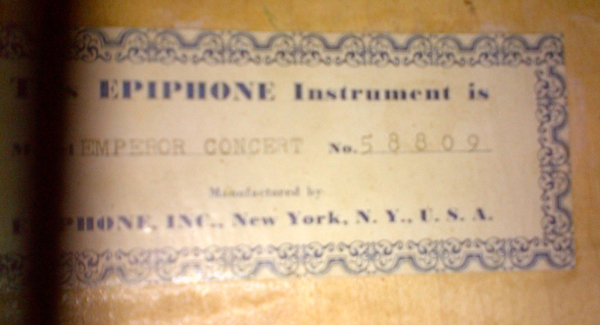
 |
|
#1
|
|||
|
|||
|
Hi folks,
over the years I owned and played a few archtops. I loved and will always love the look of an acoustic archtop! And I do know all the history and the technical things and all the differences to flattops. I absolutely think I know, how I would answer my question and it would be a short "no". Here we go: Are there any guitars which look like an archtop and sound like a typical flattop? To make it even more difficult: Sound like a typical flattop while being plugged? I know. Stupid question. But I hope that I am wrong, thinking there is nothing like this... cu erniecaster
__________________
As I am from Germany, I am not a native speaker in English. Please forgive me my mistakes. |
|
#2
|
|||
|
|||
|
Quote:
Your question is phrased in a confusing fashion. Are you asking for an archtop, that when plugged in, sounds like how a flat top acoustically sounds? In any case...... There are several archtop builders out there whose method of building gives their guitars far more sustain than the typical archtop, but just about any archtop will have way more 'punch' than any flattop will. Can you afford them, or more to the point: Will what they provide aurally give you the impetus to take out a large loan. I own a 1930 Gibson L-5 that has exactly those sound attributes because it was lightly built as a tenor L-5, but had a new 6 string neck installed at the factory in 1933. John Monteleone, Jimmy D'Aquisto and some others build with these attributes, but they are extremely expensive. Here's a video of me playing one of John's Eclipse models; one of a pair he built for Eric Clapton: Regards, Howard Emerson
__________________
My New Website! |
|
#3
|
|||
|
|||
|
Quote:
that is the question. cu. e.
__________________
As I am from Germany, I am not a native speaker in English. Please forgive me my mistakes. |
|
#4
|
|||
|
|||
|
While echoing many of the sentiments expressed by Mr Emerson can I add that there are a few arch top makers currently building guitars that come close to what you require that aren't quite so expensive as the makers he mentioned.
The Collings AT16 is one, but hard to find, Andrew Mowry builds X braced 16" archtops that he can voice to what the customer requires and his instruments are about $7000 for a custom built guitar. I've also been lucky to play a couple of early 16" Epiphones with, I think walnut back and sides, which were quite sweet and a round hole 30's Gibson L4 which a bloke brought to an Irish session once........and surprised everyone, it looked like it had been around the world in a wheelbarrow but sounded fantastic. |
|
#5
|
|||
|
|||
|
Quote:
     Yes folks, that's a genuine 1949 New York original in dead-mint condition - a near-twin to Johnny Smith's personal guitar, and one of only three known to exist; here's the back story: https://wiedler.ch/nyepireg/closeup28.html Had the "classical archtop" school not essentially crashed after WW II (a result of Segovia's 1928 American debut and the subsequent adoption of the Spanish-style guitar as the concert-hall standard, as well as changing postwar musical tastes), I could easily see one of these as a virtuoso soloist's instrument - combining balance, richness, projection, and just plain jaw-dropping good looks in one package...
__________________
"Mistaking silence for weakness and contempt for fear is the final, fatal error of a fool" - Sicilian proverb (paraphrased) |
|
#6
|
||||
|
||||
|
I have one of these old, early Gibson L-4's and I agree, it sounds fantastic; with a very "flat-top" like sound, acoustically. Not sure how it sounds amped up, since that's not how I play.
__________________
Leonard 1918 Gibson L-1 1928 Gibson L-4 (Blond w/Ebony Fret-board) 1930's Kalamazoo KG-32 1930's Gretsch F-50 1934 Gibson L-7 1934 Gibson L-50 (KG-11/14 Body Shape) 1935 Gibson L-50 (Flat-back) 1935 Gibson L-30 (Flat-back) 1942 Gibson L-50 (WWII Banner Head) 1948 Gibson L-50 1949 Epiphone Blackstone "a sharp mind cuts cleaner than a sharp tool" |
|
#7
|
|||
|
|||
|
I've always kept an eye open for one of those early round hole L4's, but they aren't so common over on this side of the Atlantic, like I said the one that I did get to play was to say the least "well worn" but it sounded fabulous and the chap who owned it had it set up beautifully, as easy to play as my old Lowden.
|
|
#8
|
|||
|
|||
|
Or perhaps a round hole Martin archtop, either the carved top C, or pressed top R, from 1931/32.
|
|
#9
|
|||
|
|||
|
Traditionally, archtops and flat-tops have been designed to do very different things - at least since the 1960s when the singer-songwriter approach changed the demand from players.
The archtop acoustic role typically being to supply a driving, cutting rythm sound and the flat-top being designed more as a support to the singer - less cutting and more inclined to "blend". Earlier flat-tops were more designed as a rythm instrument to be strummed unamplified and never really achieved the the degree of cutting through the mix that archtops do - I've never heard a flat-top "bark" like a vintage archtop...... In later years with good amplification (both miked and on-board) a finger-picked flat-top became a more fully voiced instrument as its volume capability increased. At the end of the day it will really depend on what youare aiming fokr in archtop and flat-top sounds. I'm sure you're aware of the technical dedign rationales and differences underlying all this IMHO once you've defined the sound you mean, I'm sure that for 7-10,000$ it would be feasible to commission one of today's top luthiers to build what you want - but don't expect to find one off the shelf - unless it's a Super 400, Citation or Kalamazoo Award, in which case you'll pay even more...... |
|
#10
|
|||
|
|||
|
Hi,
thank you all for your information. cu erniecaster
__________________
As I am from Germany, I am not a native speaker in English. Please forgive me my mistakes. |
|
#11
|
||||
|
||||
|
I own a D'Angeloco EX63 and it's a nice archtop for the price. With the round hole, it sounds more open than my Eastman archtop and really can get close to some flat top tones. However, since I already own a few flat tops, that's not my purpose of owning it. Here are a couple of videos on YouTube.
https://youtu.be/7N6jDwHl8v8 https://youtu.be/GMuubCEI_mc
__________________
https://www.mcmakinmusic.com |
|
#12
|
|||
|
|||
|
The archtop voice is rooted in several build-formula variables, primarily the arched top/back, carved vs pressed, and the bracing (parallel vs. X). Materials seem to matter as well (maple, mahogany, or walnut backs seem to have distinct qualities). But bracing seems to make a good bit of difference, with parallel-braced designs producing the cut/projection valued by big-band players and X-braced designs producing more sustain and a sweeter (for lack of a better descriptor) voice.
"Modern" designs combine X bracing with variations on the classic spruce-over-maple all-carved combination of classic orchestral archtops. I have a 17-inch archtop built by Tom Crandall for his own use, with the Benedetto book and old Epiphones as his guides. What I think he was aiming at was a chord-melody acoustic instrument with a fuller voice than, say, the average L-5. (Extraordinary L-5s don't count.) The result was X-braced redwood over walnut with a distinct classic-Epi look and a voice that can switch effortlessly between chunking rhythm and fingerstyle. It's sweeter than my Eastman 805CE (X-braced spruce/maple), which is in turn sweeter than my classic '46 Epi Broadway. |